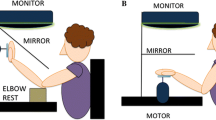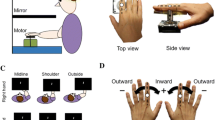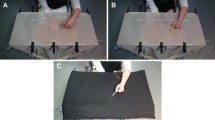Summary
The purpose of this experiment was to determine the preferred coordinate system for representation of hand orientation in 3-dimensional space. The ability of human subjects to perceive angles of the hand in 3-dimensional space (elevation, yaw, roll angles extrinsic coordinate system) was compared to their ability to perceive hand angles relative to the proximal upper limb segments (wrist joint angles, forearm pronation intrinsic coordinate system). With eyes closed, subjects performed a matching task in which the experimenter positioned the left arm, forearm and hand and the right arm and forearm. Subjects were then told to match an angle in one of the two coordinate systems by moving only the right hand at the wrist or the forearm as in pronation or roll matching. Absolute constant error (ACE), variable error (VE) and normalized variable error (NVE-normalized to tested range of motion) of matching were quantified for each subject for each of the six angles matched. It was hypothesized that matching angles in a preferred coordinate system would be associated with lower ACE, VE and NVE. Overall, ACE and VE were lower for matching hand angles in the intrinsic coordinate system. This suggests that the preferred coordinate system involved specification of hand angles relative to forearm and arm angles (joint angles) rather than the hand angles relative to axes external to the upper limb. However, matching of pronation angles was associated with larger VE and NVE than roll angle matching. There were no significant differences in ACE between pronation and roll matching. In a second experiment subjects with their forearms constrained at different elevations matched hand elevation and wrist flexion angles. Thus, errors in matching the angles in the non preferred coordinate system were predictable if the subjects were biased toward matching angles in the preferred coordinate system. Trends in the data suggested that subjects preferred matching hand elevation angles but these trends were not consistent within or between subjects. Thus a preferred intrinsic coordinate system for wrist flexion matching was not observed in this experiment. We suggest that matching angles when proximal limb segments are constrained is a simpler task for the subjects (VE lower than in the first experiment) and may bias the matching toward the extrinsic coordinate system. Thus, hand orientation in 3-dimensional space may be perceived as follows: wrist flexion and abduction angles together with forearm elevation and yaw are used to specify hand elevation and yaw; these together with hand roll angle, completely specify the hand angle in 3-dimensional space.
Similar content being viewed by others
References
An KN, Chao EY, Cooney WP, Linscheid RL (1979) Normative model of human hand for biomechanical analysis. J Biomech 12: 775–788
Andrews JG (1984) On the specification of joint configurations and motions. J Biomech 17: 155–158
Atkeson CG, Hollerbach JM (1985) Kinematic features of unrestrained vertical arm movements. J Neurosci 5: 2318–2330
Ferrell WR, Smith A (1989) The effect of loading on position sense at the proximal interphalangeal joint of the human index finger. J Physiol 418: 145–161
Giszter SF, McIntyre J, Bizzi E (1989) Kinematic strategies and sensorimotor transformations in the wiping movements of frogs. J Neurophysiol 62: 750–767
Hollerbach JM, Flash T (1982) Dynamic interactions between limb segments during planar arm movement. Biol Cybern 44: 67–77
Husleison EC, Hart FD (1987) Joint disease: all the arthropathies (4th edn). Wright, Bristol
McCloskey DI, Cross MJ, Honner R, Porter EK (1983) Sensory effects of pulling and vibrating exposed tendons in man. Brain 106: 21–37
Metzler J, Shepard RN (1986) Chronometric studies of the rotation of mental images. In: Shepard RN, Cooper LA. Mental images and their transformations. MIT Press, Cambridge Mass, pp 25–71
Moberg E (1983) The role of cutaneous afferents in position sense kinaesthesia, and motor function of the hand. Brain 106: 1–19
Proske U, Schaible H-G, and Schmidt RF (1988) Joint receptors and kinaesthesia. Exp Brain Res 72: 219–224
Sakitt B (1980) Visual motor efficiency (VME) and the information transmitted in visual motor tasks. Bull Psychol 16: 329–332
Sakitt B, Lestienne F, Zeffiro T (1983) The information transmitted at final position in visually triggered forearm movements. Biol Cybern 46: 111–118
Soechting JF (1982) Does position sense at the elbow reflect a sense of elbow joint angle or one of limb orientation. Brain Res 248: 392–395
Soechting JF, Flanders M (1989a) Sensorimotor representations for pointing to targets in three-dimensional space. J Neurophysiol 62: 582–594
Soechting JF, Flanders M (1989b) Errors in pointing are due to approximations in sensorimotor transformations. J Neuro physiol 62: 595–608
Soechting JF, Ross B (1984) Psychophysical determination of coordinate representation of human arm motion. Neuroscience 13: 595–604
Thomas DH, Long C (1964) An electrogoniometer for the finger: a kinesiologic tracking device. Am J Med Electron 4: 96–100
White WL (1960) Restoration of function and balance of the wrist and hand by tendon transfers. Surg Clin of North Am 40: 427–459
Worringham CJ, Stelmach GE, Martin ZE (1987) Limb segment inclination sense in proprioception. Exp Brain Res 66: 653–658
Worringham CJ, Stelmach GE (1985) The contribution of gravitational torques to limb position sense. Exp Brain Res 61: 38–42
Author information
Authors and Affiliations
Rights and permissions
About this article
Cite this article
Darling, W.G., Gilchrist, L. Is there a preferred coordinate system for perception of hand orientation in three-dimensional space?. Exp Brain Res 85, 405–416 (1991). https://doi.org/10.1007/BF00229417
Received:
Accepted:
Issue Date:
DOI: https://doi.org/10.1007/BF00229417




